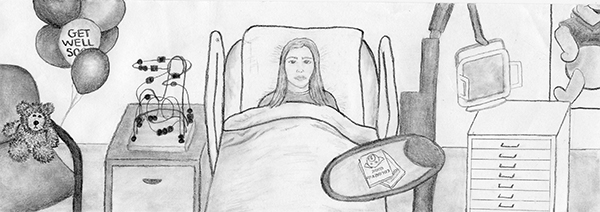Teens in hospitals lack representation and entertainment

Illustration by Ella Prillaman
February 8, 2019
I often look back on my earliest memories when I was living in Mount Prospect. One in particular has always stood out. I was about four years old, peering out of a window in my yellow room, five sparkly barrettes in my hair, wondering what I would look like when I turned 15 years old. Now, living in Glenview, having experienced 13 years of life since then, I look very similar, except for the fact that I have grown roughly three feet taller, have a couple more freckles, and have a 10-inch scar stretching vertically down my abdomen.
I remember imagining what I would look like: I would definitely be taller, I might dye my hair red, and I’d hopefully wear glasses because glasses made people look smart and I would be smart! Never once had I imagined that surgeons would need to split my dime-sized belly button apart and re-stitch it back together.
The day before my freshman year of high school, I was delivered life changing news-I had officially been diagnosed with Mid-Aortic syndrome, a condition where my abdominal aorta was narrowed to be two millimeters thick right where my renal arteries were attached. As a result, my blood pressure was too high and my left kidney began to fail. Surgery was unavoidable. Following my diagnosis, I spent three weeks at Boston Children’s Hospital receiving an abdominal, aortic bypass around the narrowing and a double-auto kidney transplant.
I had incredible amounts of support from my family, doctors, and friends. All their efforts made me feel loved and supported. Yet as I explored the medical world through my own experiences and in the media, I noticed how teenagers with health conditions are hardly represented. The medical chapter of my life became lonely and isolated.
I endured months of physical pain, but the worst was the pain resulting from my emotional journey. Nothing compared to the feeling of being alone in a community that I once was an active member in.
At Boston Children’s Hospital, I would often hobble my way to the activity center in search of a movie, and would always find to my disappointment that the DVD shelves consisted only of PBS Kids and Cartoon Network films. The hospital would deliver Sesame Street coloring books to my door at an attempt to provide me with entertainment. The walls of my room were decorated with Winnie the Pooh portraits and butterfly stickers, all of which I’m sure would entertain a five year old, but left my 15-year-old self feeling very neglected.
I have noticed how charities, hospitals, and politicians advocate for medical support through the use of medical stories of children. In Hillary Clinton’s speech at the DNC, Clinton referenced a seven-year-old boy named Ryan with a full body brace, one of many kids that inspired her health insurance advocacy.
These examples are just some of the ways in which I see society lacking advocacy for teenagers with medical conditions. Don’t get me wrong, it is important for children to be entertained in the hospital, even more so to receive treatment, but it’s just as important for teenagers to get the same privileges.
Whether it be a broken leg, pneumonia, or a medical condition such as mine, many teenagers spend some of their most stressful moments of life tangled in IVs. Perhaps the use of donations towards a more broad movie selection ranging beyond G-rated films, and advocacy for the medical treatment of teenagers in healthcare debates would help them experience the world beyond their hospitals pale blue walls. Although teenagers are older and vastly more independent than children, they still deserve the care and empathy from society that children are more prone to receive.


